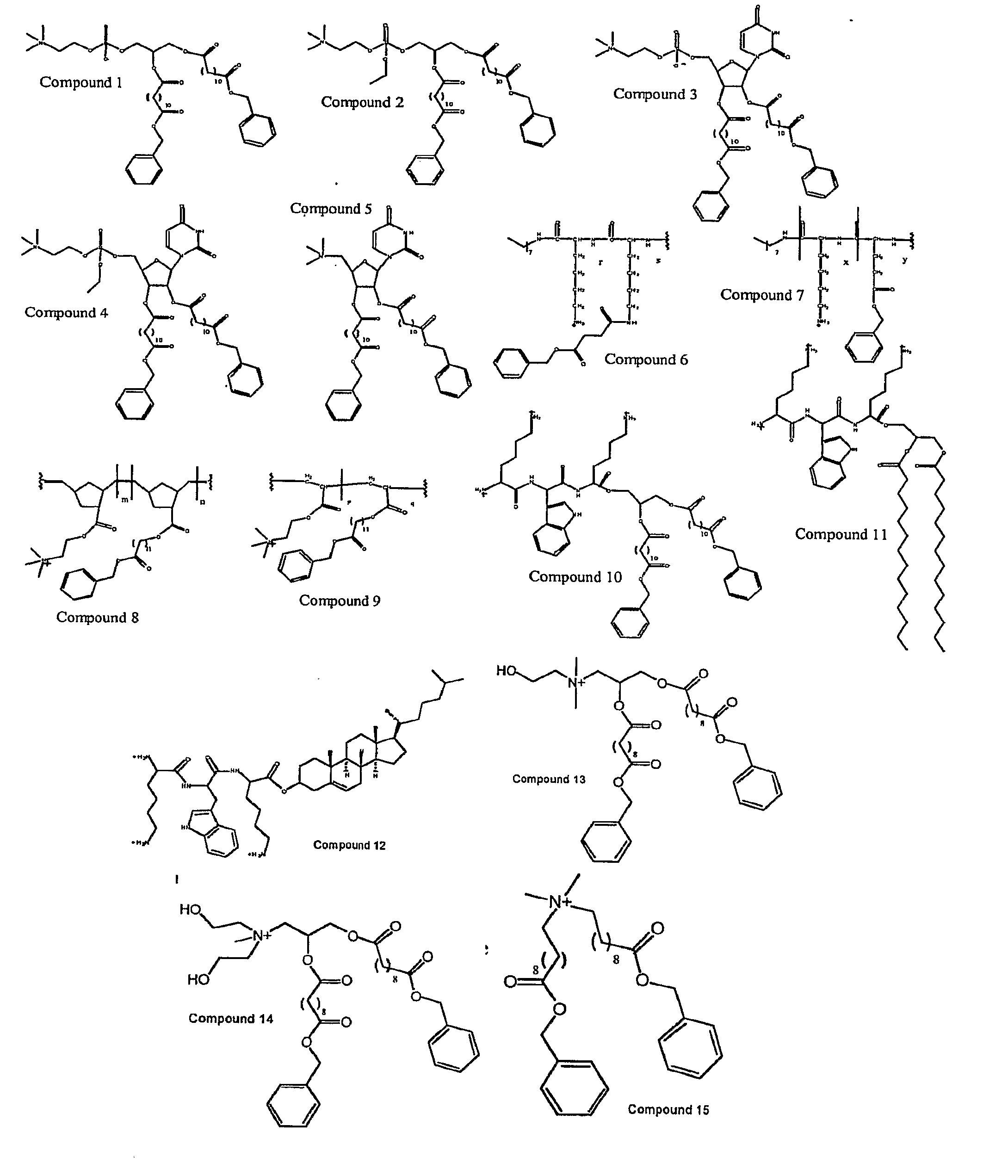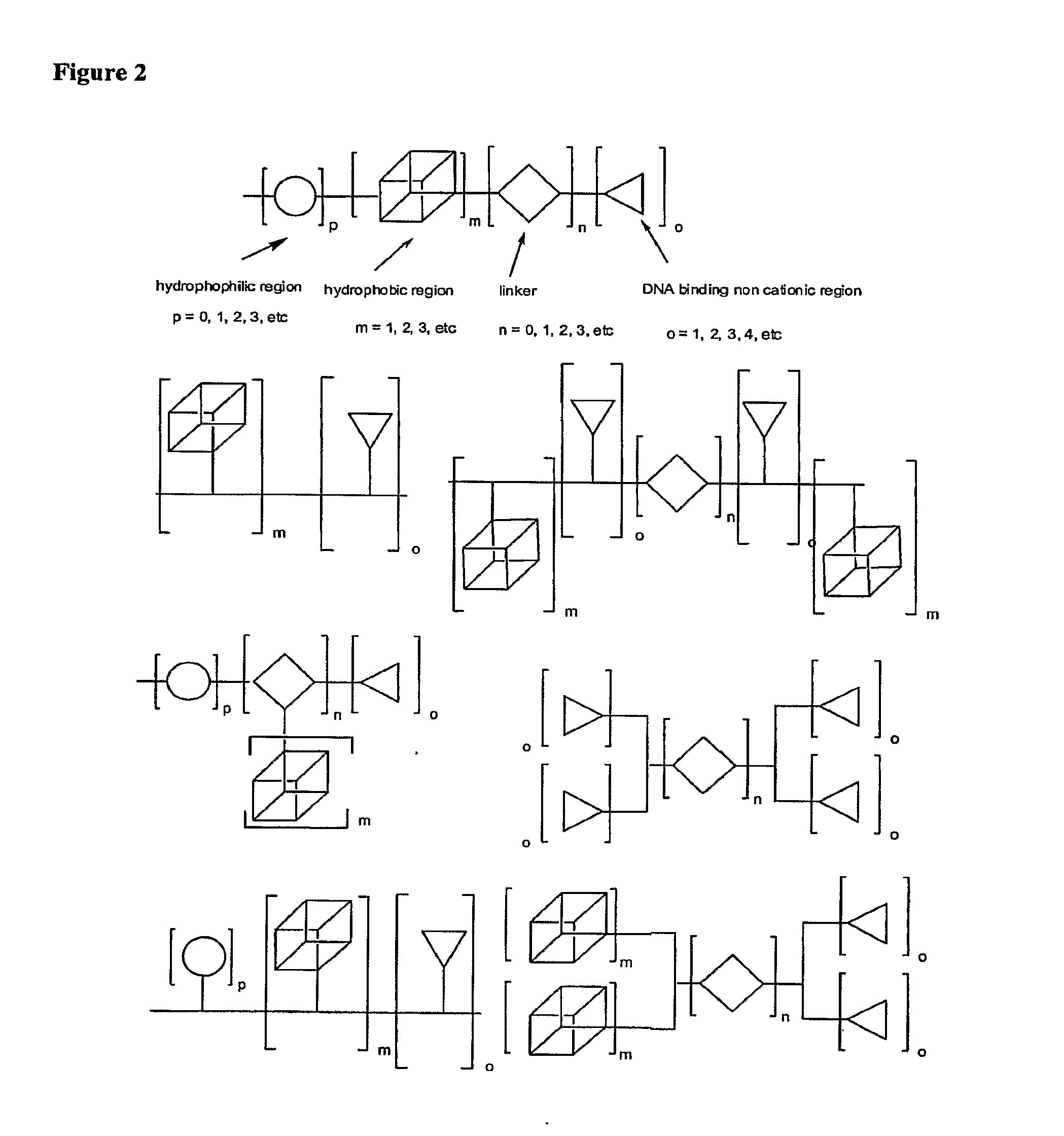Molecules for Gene Delivery and Gene Therapy, and Methods of Use Thereof
a gene and gene technology, applied in the direction of group 5/15 element organic compounds, peptides, drug compositions, etc., can solve the problems of large size and polyanionic nature of penetration of nucleic acids into cells or target organs, risks associated with endogenous virus recombination, and inflammatory or immunologic reactions
- Summary
- Abstract
- Description
- Claims
- Application Information
AI Technical Summary
Benefits of technology
Problems solved by technology
Method used
Image
Examples
example 1
[0384]
[0385]Dodecanedioic acid monobenzyl ester: Dodecanoic diacid (1 mmol) and Dowex 50W-X2 (50-100 mesh) (1.0 g) were stirred in benzyl formate / octane (2:8, 10 mL) at 80° C. The reaction was stirred for 12 h. The solution was then filtered and the filtrate evaporated. The crude product was purified by column chromatography (Hexane / EtOAc 8:2) to afford the compound as a white powder.
[0386]3-tert-butyldiphenyl silyl-sn-glycerol: Glycerol (1 mmol), tert-butyldiphenyl silane chloride (1 mmol) and imidazole (1 mmol) were dissolved in DMF. The reaction mixture was stirred for 2 days. The solution was filtered and the solvent removed under reduced pressure. The crude product was purified by column chromatography (Hexane / EtOAc 8:2) to afford the compound as a white powder.
[0387]1,2-Di-dodecanedioyl benzyl ester-3-tert-butyl diphenyl silyl-rac-glycerol: To a solution of dodecanoic acid benzyl ester (2.2 mmol), sn-glycero-3-tert-butyl diphenyl silane (1, mmol) and DMAP (catalytic amount) in...
example 2
[0391]
[0392]Boc-Glu(OBzl)-ONSu: To a solution of Boc-Glu(OBzl)-OH (1.26 mmol) and HONSu (1.39 mmol) in THF at −20° C., was added DCC (1.39 mmol). The mixture was stirred overnight at −20° C. The DCU was removed by filtration and the THF was removed by evaporation under vacuum. The crude compound was purified by recrystallization from ether.
[0393]Boc-Lys(boc)-ONSu: Same procedure used then that described for Boc-Glu(OBzl)-ONSu.
[0394]Boc-Glu(OBzl)-Glu(OBzl)-OH: To a solution of L-Glu(OBzl) (1.3 mmol), and NaHCO3 (1.4 mmol) in water, was added a solution of Boc-Glu(OBzl)-ONSu in THF. The mixture was stirred overnight at room temperature. The solution was evaporated and acidified with 10% citric acid and extracted with ethyl acetate. The solution was washed with brine and dried over sodium sulfate. The crude product was purified by recrystallization from ether.
[0395]Boc-Lys(boc)-Lys(boc)-OH: Same procedure as described for Boc-Glu(OBzl)-Glu(OBzl)-OH.
[0396]Boc-Glu(OBzl)-Glu(OBzl)-ONSu: T...
example 3
[0413]
[0414]12-hydroxy-dodecaonoic acid benzyl ester: To a solution of 12-hydroxy-dodecanoic acid (4.62 mmol) in 7 mL DMF was slowly added at 0° C. benzyl bromide (6.43 mmol) and DBU (7.23 mmol). DMF was removed under reduced pressure. The residue was dissolve in dichloromethane and washed with 1 M HCl and NaHCO3, dried over NaSO4. A white powder was obtained after purification through silica gel column (EtOAc / hexanes 2:8). Benzyl ester / alkyl chain / bicyclic monomer: To a solution of endo / exo-bicyclo[2.2.1]hept-5-ene-2-carboxylic acid (3.62 mmol) and 12-hydroxy-dodecanoic acid benzyl ester (3.62 mmol) in 10 mL CH2Cl2 was added a solution of DCC (3.98 mmol) and DMAP (0.4 mmol) in 5 mL CH2Cl2 at 0° C. After stirring at room temperature overnight, the solution was filtrate and purified through silica gel column (EtOAc / hexanes 2:8). A colorless oil was obtained in 97% yield.
[0415]Ethanolamine / bicyclic monomer: To a solution of endo / exo-bicyclo[2.2.1]hept-5-ene-2-carboxylic acid (2.17 mmo...
PUM
| Property | Measurement | Unit |
|---|---|---|
| Amphiphilic | aaaaa | aaaaa |
Abstract
Description
Claims
Application Information
 Login to View More
Login to View More - R&D
- Intellectual Property
- Life Sciences
- Materials
- Tech Scout
- Unparalleled Data Quality
- Higher Quality Content
- 60% Fewer Hallucinations
Browse by: Latest US Patents, China's latest patents, Technical Efficacy Thesaurus, Application Domain, Technology Topic, Popular Technical Reports.
© 2025 PatSnap. All rights reserved.Legal|Privacy policy|Modern Slavery Act Transparency Statement|Sitemap|About US| Contact US: help@patsnap.com



